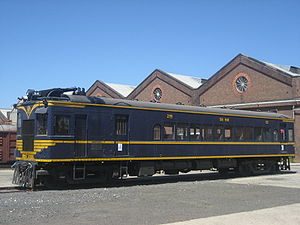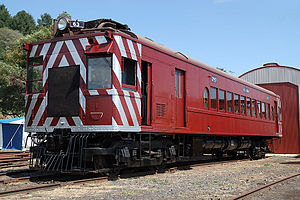- Diesel Electric railmotor (VR)
-
D.E.R.M. (originally P.E.R.M.) RM58 At Newport Workshops Power type Diesel engine, Originally Petrol Designer St Louis Car Company Builder St Louis Car Company (First)
Victorian RailwaysBuild date 1928 - 1931 Total produced 10 Locomotive weight 34 pounds Power output 220 hp (Petrol), 255 bhp (Diesel) The Diesel Electric Rail Motor (commonly referred to as a DERM) was a railmotor operated by the Victorian Railways of Australia.
Contents
History
Originally built as a Petrol Electric Rail Motor (PERM) they were the longest-lived railmotor on the Victorian Railways, with the first entering service in 1928 and the last being withdrawn in 1991. The first railmotor was built by the St. Louis Car Company and shipped to Australia where the Victorian Railways built a further 9 copies of it. It was powered by a 220 hp Winton petrol engine which was used until the 1950s when they were converted to twin Diesel Electric engines giving a total of 255 bhp.[1]
By the 1970s the longest regular scheduled journey run by a DERM was the Bendigo to Robinvale run, withdrawn on 3 June 1978. A DERM with a DERM Trailer car ran a regular passenger train on the South Gippsland Line from the 1960s - 1970s.[2] In the late 70's RM 55 and RM 61 were extensively modified with the cab being rebuilt, the engine being relocated and the engine room rebuilt with porthole windows, and new aluminium cabin windows fitted. As such they looked significantly different, as can be seen in this photo.[3]
DERMs with the porthole windows were a familiar sight on the Mornington and Stony Point lines prior to the line closures in the early 1980s.
Preservation
55RM and 61RM are operational on the South Gippsland Tourist Railway. 63RM was restored to the 1930's livery of dark red with silver stripes and runs on the Daylesford Spa Country Railway. 58RM is preserved for mailine use by the Diesel Electric Rail Motor Preservation Association Victoria at the Newport Workshops along with RM64 which is under restoration and 60RM which is stored. 62RM is undergoing restoration at the Yarra Valley Tourist Railway and 59RM is stored at the Mornington Railway. 57RM is the only DERM to have been scrapped. DERM 56, which is stored at Newport Workshops, is apparently going to be sold to the South Gippsland Tourist Railway.
See also
- Tourist and Heritage Railways Act
References
- ^ "DERM railmotors". www.victorianrailways.net. http://www.victorianrailways.net/motive%20power/derm.html. Retrieved 2008-06-04.
- ^ Chris Banger (March 1997). "Rail Passenger Service Withdrawals Since 1960". Newsrail (Australian Railway Historical Society (Victorian Division)) 25 (3): pages 77–82.
- ^ "Photo of modified DERM". www.victorianrailways.net. http://www.victorianrailways.net/motive%20power/rmpics/rm55mod.jpg. Retrieved 2008-04-05.
Locomotives and rollingstock of the Victorian Railways and successors Steam 'Old' A Class · 'New' A Class · AA Class · A2 Class · B Class · C Class · D Class · Dd Class · E Class · F Class · H Class · J Class · K Class · L Class · M Class · N Class · O Class · P Class · Q Class · 'Old' R Class · 'New' R Class · R Class · S Class · T Class · U Class · 'Old' V Class · V Class · W Class · X Class · Y Class · Z Class · Crane locomotivesDiesel-Electric Diesel-Hydraulic M class · V class · W classElectric Road Transferrable Locomotives RTL ClassCarriages Fixed wheel carriages · A/AA type carriages · AA/A type carriages · BG type carriages · E type carriages · H type carriages · K type carriages · N type carriages · PL type cars · S type carriages · V type carriages · W type carriages · Z type carriages · Royal Trains · Dining & Buffet cars · Sleeping cars · Joint and shared stock (SAR) · Joint and shared stock (NSWGR)Railmotors McKeen · Kerr Stuart · AEC · Leyland · DERM · 102hp Walker · 153hp Walker · 280hp Walker · DRC railcar · Sprinter DMU · VLocity DMU · Trailer carsSuburban electric Freight vehicles Car Transport · Box & Louvre vans · Flat Wagons · Hopper wagons · Livestock · Open wagons · Tank wagonsVans 2 ft 6 in (762 mm) Narrow Gauge Other Categories:- Victorian Railways railmotors
- Victoria (Australia) rail transport stubs
Wikimedia Foundation. 2010.



